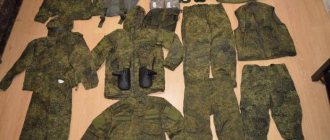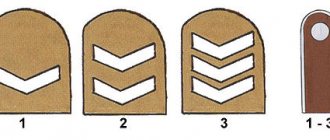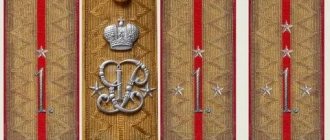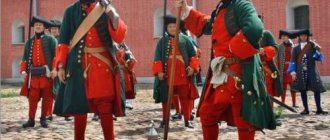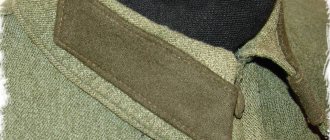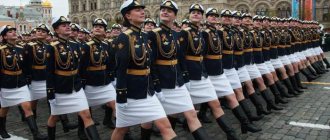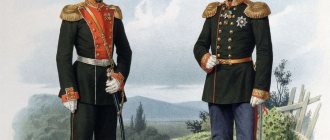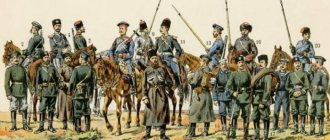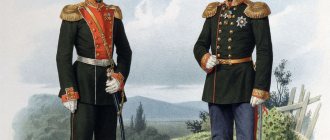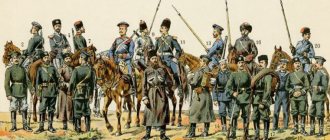04/07/2019 Military clothing: purpose and types
Tweet
Military uniforms are standardized clothing worn by members of the armed forces and paramilitary forces of various countries.
Military uniforms have undergone significant changes over the centuries, from colorful and elaborately patterned clothing before the 19th century, to utilitarian camouflage uniforms for field and combat purposes beginning with World War I (1914-1918).
Military uniform, in the form of a uniform and distinctive outfit intended for identification and display, is usually the sign of an organized military force equipped by a central authority.
What can't you do in military uniform?
Military personnel are prohibited from keeping their hands in their pockets, sitting or smoking in the presence of a superior (senior) without his permission, as well as smoking on the streets while moving and in places not designated for smoking.
Interesting materials:
How to properly store cashmere sweaters? How to properly store kefir grains? How to properly store porcelain stoneware? How to properly store chemical reagents? How to properly store jellied meat in the refrigerator? How to properly store kimchi? How to properly store boiled milk? How to properly store coconut paste? How to properly store smoked suluguni cheese? How to properly store hazelnuts?
Types of modern military uniforms
The utilitarian needs of war and economy are the dominant factors in uniform military uniform design today. However, most of the world's armed forces have developed several different types of uniforms.
Military uniforms differ not only depending on military units, but are also offered in different types in accordance with Western standards:
- dress uniform for ceremonial wear,
- uniform for everyday wear,
- combat uniform (also called "combat/field uniform"), which sometimes corresponds to the everyday uniform,
- Sometimes, clothing for physical exercise is added to the casual category.
All types of uniforms can be viewed by opening this page. And we will dwell in more detail on some examples.
As noted above, traditional colored uniforms have long given way to clothing more suitable for combat in modern conditions. The bright colors of military uniforms are now generally reserved for wear by units performing ceremonial functions or by certain groups and officers attending official events.
However, elite army units usually manage to have some distinctive features of their own. The United States Marine Corps is well known for its traditional blue uniforms and trousers with red trim. British cavalry and foot guards wear uniforms, largely unchanged since 1914, for "public duties", that is, ceremonial.
Militaries in many countries have adopted the cost-effective use of combat uniforms for parades, adding awards, neckerchiefs and colored berets to camouflage uniforms intended for combat.
As an interesting example, the combination of old and new uniform features: the French Spahis and Spanish Regulares still wear the cloaks, fez, turbans and sashes of the North African colonial regiments, which they combine with modern khaki or camouflage uniforms, as appropriate. .
General classification of clothing
Clothing is divided into types based on its purpose, functionality, climatic characteristics, production technology and other factors.
First of all, clothing items are:
- men's,
- women's,
- children's,
- unisex.
Further, they are divided into:
- Shoulder clothing - the one that rests on the upper body. These are coats, raincoats, jackets, jackets, blouses, sweaters, dresses, vests and so on.
- Belt clothing is held on the lower part of the body (trousers, skirts, shorts).
According to functionality, clothing is classified as follows:
- Outerwear - it is worn over underwear and costume and dress items. We are talking about coats, raincoats, jackets, etc.
- Light outerwear is what is worn over underwear. We are talking about suits, shirts, blouses, dresses, trousers, skirts.
- Corsetry is worn directly on the body to support the skeleton and shape the figure. This class includes corsets, bras, and hosiery belts.
- Underwear . These items - panties, T-shirts - have mainly a hygienic purpose.
The climatic characteristic implies that clothing is:
- summer,
- winter,
- all-season,
- demi-season.
Performance goals group clothing into:
- household - home, everyday, formal, sports, national;
- production - special, sanitary, uniform.
Based on their manufacturing technology, clothes are classified as follows:
- sewing products,
- knitted,
- felted
According to the type of production, there are clothes:
- mass, created in factories and produced in large quantities.
- Clothes made to order.
Fashionable clothing, samples of which are offered by designers, has its own classes:
- ready-to-wear – branded items introduced into mass production.
- Haute couture or high fashion clothing are unique, one-piece pieces created by famous fashion designers.
Considering the material, clothing is divided into:
- fur,
- leather,
- fabric,
- feather-down,
- polymer-rubber.
All types of clothes
Let's start with warm clothes. * uni - universal f - female m - male
Outerwear
Coat and its types
In a broad sense, a coat is a warm garment with sleeves and length below the hips. Experts distinguish more than 20 modifications of this item.
Balmakaan is a men's single-breasted coat of a strict shape with a shirt-type collar and a placket covering the buttons.
Balmakaan coat
Pea coat is a men's/women's double-breasted cropped coat with a laid-back collar and two rows of buttons.
Pea coat
Duster is a practical, lightweight women's coat, knee-length and below.
Duster
Duffle coat is a knee-length coat with a hood, patch pockets and buttons on leather hinged loops.
Duffle coat
Sheepskin coat is a coat made of skins with the inside out.
Sheepskin coat
Inverness - can be both male and female. Instead of sleeves, this product has a cape sewn into it.
Inverness
Cape - a type of coat, features - no sleeves, trapezoidal shape, fastening at the throat.
Cape
Covercoat is a straight single-breasted coat. Designed for hunting, it features durable fabric and multiple stitching.
Covercott
Cocoon is a women's loose coat with a contour resembling a cocoon.
Cocoon coat
Kopar is predominantly a men's coat, knee-length and below, made of leather.
All types of clothing – Kopar
Crombie is a type of coat of a straight or fitted style with a hidden fastener.
A coat is an exclusively feminine attribute: a spacious, wide-cut coat, most often made of fur.
Manto
Ulster is a piece of clothing originally from Ireland. Characterized by volume and maxi length.
Ulster
A wrap coat is a double-breasted garment without buttons.
Wrap coat
Pardesu is a short-length coat with two sides. It was used for horseback riding, and is now popular among car owners.
Pardesu
Polo is a coat with a loose silhouette. Recognizable thanks to the English collar and peaked lapels.
Polo coat
Poncho is a coat-cape, a transformation of the national clothing of the Indians. In a modern interpretation, it can be with sleeves, a hood, or a belt.
Poncho
Down jacket is winter clothing filled with down.
Down jacket
Raglan - can be both male and female. Its “highlight” is the absence of a standard armhole and a loose sleeve that gently flows around the shoulders.
Raglan
The redingote is a fitted model, slightly wider at the bottom. Sewn with wide lapels and flap pockets.
Redingote
Swinger - a coat in the style of the 60s: loose, short, trapezoidal.
Swing Coat
Trench coat is a coat with or without sides. Typical details are a folded collar, a belt and vent, a yoke on the back, tabs and shoulder straps. Since the trench coat combines the functions of a coat and a raincoat, it is sewn from waterproof fabric.
Trench coat
Chesterfield is a traditional English coat. Characteristic features: semi-fitting silhouette, short lapels, flap pockets.
Chesterfield
An overcoat is a variant of a straight or fitted coat with a fold at the back. Supplemented with metal buttons, shoulder straps, and a ribbon.
Overcoat
Cloak and its types
Essentially, this is a coat, but less dense, made from water-resistant fabric. The purpose of the cloak is to protect in bad weather.
Popular models:
English - a raincoat of a conservative cut with a belt and a turned-down collar.
English cloak
Hubertus is an insulated version with a high collar. The purpose of the humerus is to cover it from both rain and wet snow, so it is often trimmed with fur.
Hubertus
Raincoat is a spacious raincoat with a hood made of waterproof material.
Raincoat
A mackintosh is a raincoat modeled after a men's coat from the middle of the last century. It is straight-cut, without lapels, and made of rubberized fabric.
Mac
A robe-robe is a model for women. It has a loose silhouette, oversized style and a belt, like a bathrobe.
Cloak-robe
A trench coat is a product with a wide double-breasted collar, a cutout at the back, cuffs, a belt and shoulder straps.
Trench coat
The “family” of raincoats also includes such specific types as a cloak-tent, burqa, and mantle.
